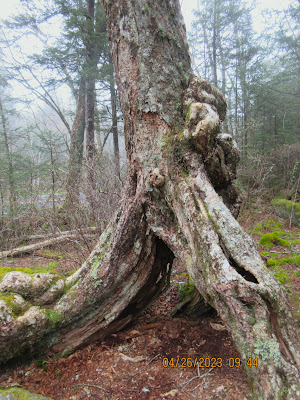This sums up the weather for this year's Pilgrimage.
The week began with 2 high elevation hikes. Both were over 5000'. One in a Spruce-Fir forest and the other in a Beech Gap forest. Red Spruce is the dominant species in the Spruce-Fir forest. Smaller Balsam Firs are trying to recover from the devastation caused by the Balsam Wooly Adelgid. Both are dressed in lush lichens. Moss carpets the forest floor soaking up the rain.
Over in the Beech Gap, an experimental exclosure was build to keep wild boars from digging up the vegetation. Spring Beauties cover the ground in such quantities that it appears to have snowed.
Viburnum was blooming. The pollenating flowers are the small ones. Viburnum's large flowers are sterile and are there as a pollinator's target.
Next hike is Husky Gap and Cucumber Gap. It is still raining. We were bused from the Sugarlands parking area to the trailhead. While awaiting, this Crossvine was spotted. It is often overlooked since its showy blooms are high up trees. In the winter you may spot it since it is a semi-evergreen whose leaves turn from dark green to reddish purple.
My favorite fern, Walking Fern is usually seen on rocks. It spreads when one of its leaves touches the ground, a new plantlet will grow.
I've never seen Large Whorled Pogonia before. There were a couple groups of these orchids trailside. Even the botanists were stoked.
It's hard to find Yellow Lady Slippers when there is some much Luteum. Yet, we prevailed and saw a half dozen. The other plant I was searching for here, was the Yellow Trillium with 21 leaves. As we were admiring the Yellow Lady Slippers, Jerry poked me and said "there it is". Sure enough, right there next to the Lady Slipper were the 6 Yellow Trillium individuals with multiple leaves. None had flowers, just extra sets of leaves.
21 leaf Trillium Luteum
After a pleasant lunch break on the banks of Little River, our hike continued onto Cucumber Gap. This trail had a few Painted Trillium and many Showy Orchis.
On the final day, we are headed to Collins Creek for a Moss walk. Nanci and I were the only pilgrims to attend so it was a personalized walk with a couple UT botanists. I couldn't resist taking a photo of some Golden Alexander (above).
Mosses were one of the first plants to emerge from the oceans onto land, 450 million years ago, They are found on every continent. They are non-flowering and produce spores to reproduce. They also don't have a root system. We picked a small single tuft to examine. When finished, it was placed right back where it came from so it could continue thriving. This rosette shaped moss was a particularly interesting one.
























No comments:
Post a Comment